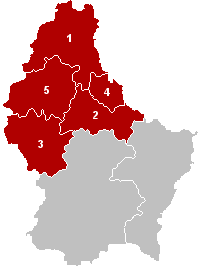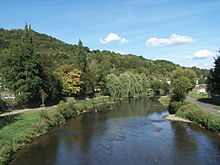Diekirch District
Diekirch District | |
|---|---|
 Location of the Diekirch district | |
| Coordinates: 49°52′N 6°10′E / 49.867°N 6.167°E | |
| Country | Luxembourg |
| Capital | Diekirch |
| Subdivisions | |
| Area | |
| • Total | 1,157.2 km2 (446.8 sq mi) |
| Population (2014) | |
| • Total | 83,661 |
| • Density | 72/km2 (190/sq mi) |
| [1] | |
| Time zone | UTC+1 (CET) |
| • Summer (DST) | UTC+2 (CEST) |
| ISO 3166 code | LU-D |
The District of Diekirch (French: Diekirch, German: Diekirch, Luxembourgish: Dikrech) was one of three districts of the Grand Duchy of Luxembourg. Its capital was the city of Diekirch.
In 2015, the districts were abolished.[2]
It was the northernmost of the districts and, with an area of 1,157.2 km2 (446.8 sq mi), the largest of the three districts. It has a population of 83,661 inhabitants and a population density of 72.3 inhabitants/km², the lowest density of all districts.[1]
History[change | change source]
When the districts were created on 24 February 1843, Diekirch was one of the three of the country.[3]
On 2012, the communes of Heinerscheid and Munshause were made part of the commune of Clervaux; Hosingen, Consthum and Hoscheid were merged to made the new commune of Parc Hosingen; Ermsdorf and Medernach were merged to made the new commune of Vallée de l'Ernz; Heiderscheid and Neunhausen were joined to Esch-sur-Sûre. So the number of communes changed from 43 to 36.[4]
Geography[change | change source]
The Diekirch district is bordered to the west and north by Belgium (Belgian provinces of Luxembourg and Liège), to the east by Germany (German Land of Rhineland-Palatinate, to the south by the Luxembourg district and to the southwest by the Grevenmacher district.
The two highest hills in Luxembourg, the Kneiff (560 m [1,837 ft]) and Buurgplaatz (559 m [1,834 ft]), are in this district, in the commune Troisvierges.[5]
The former Diekirch District coincides with the Oesling Region, except for the southern parts.
Composition[change | change source]
The Diekirch district has 5 cantons and 36 communes.

| Canton | Capital | Area[6] (km²) |
Population[1] (2014) |
Density (inhab./km²) |
Communes | |
|---|---|---|---|---|---|---|
| 1 | Clervaux | Clervaux | 342.2 | 16,447 | 48.1 | 5 |
| 2 | Diekirch | Diekirch | 204.5 | 30,460 | 148.9 | 10 |
| 3 | Redange | Redange | 267.5 | 17,086 | 63.9 | 10 |
| 4 | Vianden | Vianden | 78.5 | 4,722 | 60.2 | 3 |
| 5 | Wiltz | Wiltz | 264.6 | 14,946 | 56.5 | 8 |
Cantons and their communes[change | change source]



References[change | change source]
- ↑ 1.0 1.1 1.2 "Population by canton and municipality 1821 - 2014". Statistics Portal - Grand Duchy of Luxembourg. Retrieved 26 April 2014.
- ↑ "Loi du 2 septembre 2015 portant abolition des districts" (PDF) (in French). Service central de législation. Retrieved 20 May 2016.[permanent dead link]
- ↑ (in French and German) "Mémorial A, 1843, No. 17" (PDF). Service central de législation. p. 45. Archived from the original (PDF) on 5 March 2016. Retrieved 26 April 2014.
- ↑ (in French) "Mémorial A, 2011, No. 110" (PDF). Service central de législation. Archived from the original (PDF) on 19 October 2013. Retrieved 26 April 2014.
- ↑ (in French) "Recueil de statistiques par commune" (PDF). Statistics Portal - Grand Duchy of Luxembourg. 2003. p. 20. Archived from the original (pdf) on 10 June 2007. Retrieved 26 April 2014.
- ↑ "Surface area of the cantons and municipalities". Statistics Portal - Grand Duchy of Luxembourg. Retrieved 26 April 2014.
